
Original Link: https://www.anandtech.com/show/1814
ATI's X1000 Series: Extended Performance Testing
by Derek Wilson on October 7, 2005 10:15 AM EST- Posted in
- GPUs
Introduction
With our recent architecture and feature set coverage over the ATI Radeon X1000 series launch, we were a little bit light on the performance numbers. Rather than fill out some of the tests and update the article, we decided to take a little more time and do it up right. We have heard the call for more game tests, and today, we bring them on in spades. Our expanded tests include the games mentioned in our earlier coverage, the much requested Battlefield 2, and we illustrate the stellar way in which the new X1000 series handles enabling 4xAA on the games that we tested.
While scaling-with-aa on the new X1000 series is very good, will it be good enough to make up for the price difference with competitive NVIDIA hardware? Certainly, the feature set is of value with ATI offering the added benefit of MSAA on MRT and floating point surfaces, high quality AF, SM3.0, and Avivo. But performance is absolutely critical on current and near term games. Currently, many HDR methods avoid floating point output and MRTs in order to maintain compatibility with AA on current hardware. Until game developers shift to full floating point framebuffers or make heavy use of multiple render targets, ATI's added AA support won't make much difference to gamers. High quality anisotropic filtering is definitely something that we have begged of NVIDIA and ATI for a long time and we are glad to see it, but the benefits just aren't that visible in first-person shooters and the like. Shader Model 3.0 and Avivo are good things to have around as well; better API support, image quality, and video output are things that everyone wants.
However, the bottom line is that performance sells video cards. The first thing that people question when they are looking for a new card is just how well it runs in their favorite game. Hopefully, we will be able to shed some light on the issue here.
We will look at resolutions from 800x600 up to 2048x1536 and antialiasing tests will be included where possible. In games where we tested both with and without antialiasing, we will also show a graph of how performance drops due to AA scales with resolution. This data will be a lower-is-better graph (less drop in frame rate is a good thing) and will be shown scaled over resolution (as a performance drop will increase in percentage with resolution). The test system that we employed is the one used for our initial tests of the hardware.
Battlefield 2 Performance
The most requested game that we didn't include in our initial coverage is Battlefield 2. This highly popular game is quite important in comparing performance, as it does an excellent job of setting the standard for first-person shooter quality. The numbers that we attained came from running our custom BF2 demo on the highest quality settings. This means that anisotropic filtering was enabled both with and without AA (as Doom 3's high quality mode also enables AF).
Our "no AA" performance numbers show the X1800 XT performing on par with the 7800 GTX until we move beyond 1600x1200. The 7800 GT has an advantage over the X1800 XL as well. The most important thing to note is that this is the only test that we have run to show the X1600 XT performing on the level of the GeForce 6800 GT. While it is good to see the new mid-range part performing in its price class, one title is not enough to make it worth the $250. The "budget" X1300 doesn't quite perform as well as the 6600 GT, which looks to sell at about the same price.
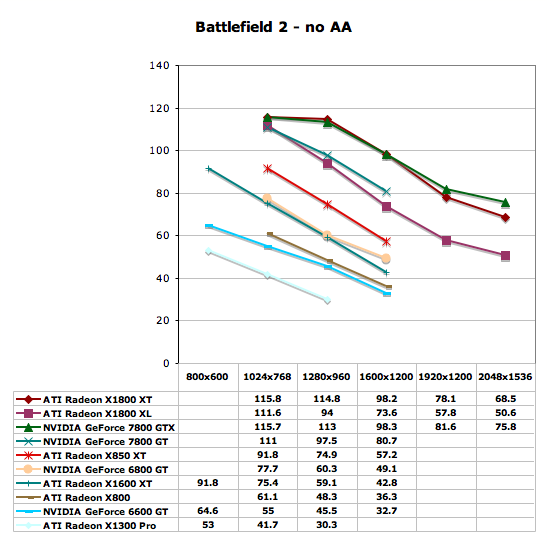
After enabling 4xAA on Battlefield 2, the X1800 XT really stretches its legs. Likewise, the X1800 XL jumps ahead of the 7800 GT. When we move to the X1600 XT, the numbers show it falling further behind the 6800 GT.

The X1800 XT bearly breaks a sweat when AA is enabled dropping at most 18.3 percent. In fact, at every resolution, the X1800 XT drops about half the percent decrease in performance as seen on the 7800 GTX explaining the change in leadership between our two tests. Dropping more than the 6800 GT and less than the 6600 GT (percentage-wise), the X1600 XT shows different characteristics than its heavier hitting siblings.
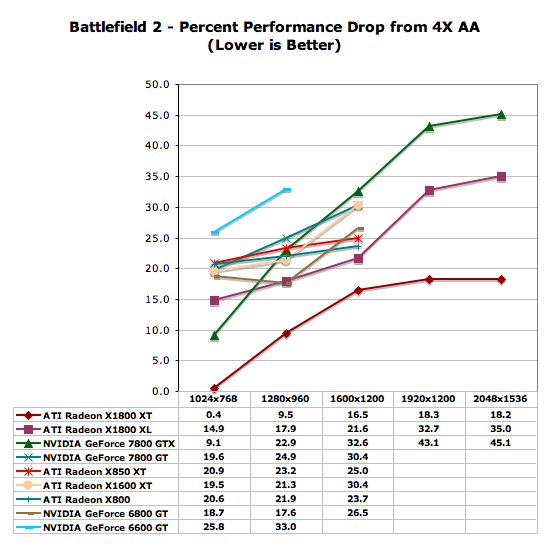
Next up is Day of Defeat: Source. We already had a peak at this game's performance earlier this week. Now, let's see if our extended data supports what we saw then.
Day of Defeat: Source Performance
Rather than test Half-Life 2 once again, we decided to use a game that pushed the engine further. The reworked Day of Defeat: Source takes 4 levels from the original game and adds not only the same brush up given to Counter Strike: Source, but HDR capabilities as well. The new Source engine supports games with and without HDR. The ability to use HDR is dependent on whether or not the art assets needed to do the job are available.
In order to push this test to the max, the highest settings possible were tested. This includes enabling the reflect all and full HDR options. Our first test was run with no antialiasing and trilinear filtering, and our second set of numbers was generated after 4x antialiasing and 8x anisotropic filtering were enabled.
From the looks of our graph, we hit a pretty hard CPU barrier near 80 frames per second. The 7800 GTX sticks the closest to this limit for the longest, but still can't help but fall off when pushing two to three megapixel resolutions. The 7800 GT manages to out-perform the X1800 XT, but more interestingly, the X850 XT and X1800 XL put up nearly identical numbers in this test. The X1300 Pro and the X1600 XT parallel each other as well, with the X1600 XT giving almost the same numbers as the X1300 Pro one resolution higher. The 6600 GT (and thus the 6800 GT as well) out-performs the X1600 XT pretty well.
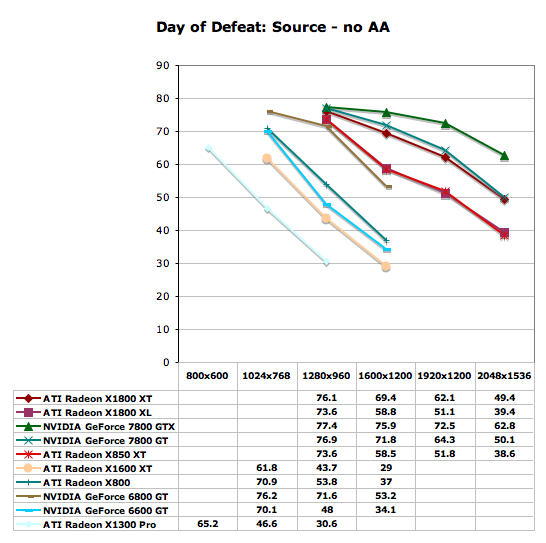
Antialiasing changes the performance trends a bit, but at lower resolutions, we still see our higher end parts reaching up towards that 80 fps CPU limit. The biggest difference that we see here is that the X1000 series are able to gain the lead in some cases as resolution increases with AA enabled. The X1800 XT takes the lead from the 7800 GTX at 1920x1200 and at 2048x1536. The 7800 GT manages to hold its lead over the X1800 XL, but neither is playable at the highest resolution with 4xAA/8xAF enabled. The 6600 GT and X1600 XT manage to stop being playable at anything over 1024x768 with AA enabled. On those parts, gamers are better off just increasing the resolution to 1280x960 with no AA.
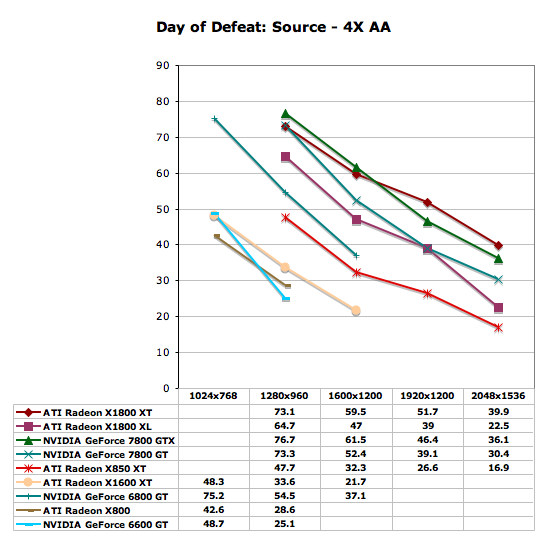
The 7800 series parts try to pretend that they scale as well as the X1800 series at 1600x1200 and below when enabling AA. The X850 XT scales worse than the rest of the high end, but this time, the X1600 XT is able to show that it handles the move to AA better than either of the X8xx parts test and better than the 6600 GT as well. The 6800 GT takes the hit from antialiasing better than the X1600 XT though.
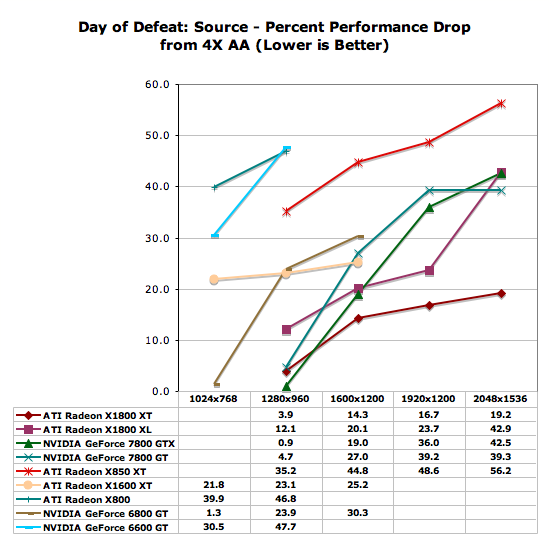
Doom 3 showed NVIDIA hardware leading at every step of the way in our previous tests. Does anything change when looking at numbers with and without AA enabled?
Doom 3 Performance
NVIDIA hardware just runs Doom 3 better than ATI hardware, and as we saw before, the case hasn't changed with the new R/RV5xx GPUs from ATI. The light and shadows in Doom 3's engine play a huge role in the game, and the algorithms and API (OpenGL) just tend to favor NVIDIA's architecture and drivers.
The 7800 GTX and 7800 GT both out-perform the X1800 XT across the board without AA enabled. The 6800 GT manages to run faster than the X1800 XL, and the 6600 GT leads the X1600 XT by huge margins. The X1300 Pro stops being playable after 1024x768, which really doesn't bode well for a $150 card.
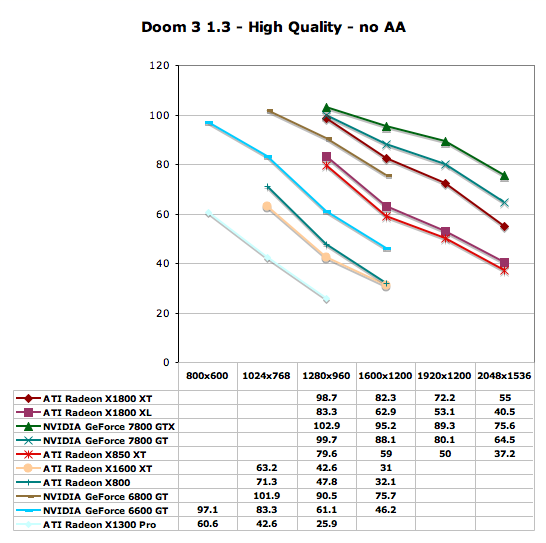
Performance falls off faster with AA enabled, but that is to be expected. The 7800 GTX and 7800 GT just increase their ability to out-perform the X1800 series here, but the X1600 XT becomes more competitive with the 6600 GT this time around. Of course, neither one really does that well at 1024x768 with 4xAA - 44 FPS is playable, but just barely.
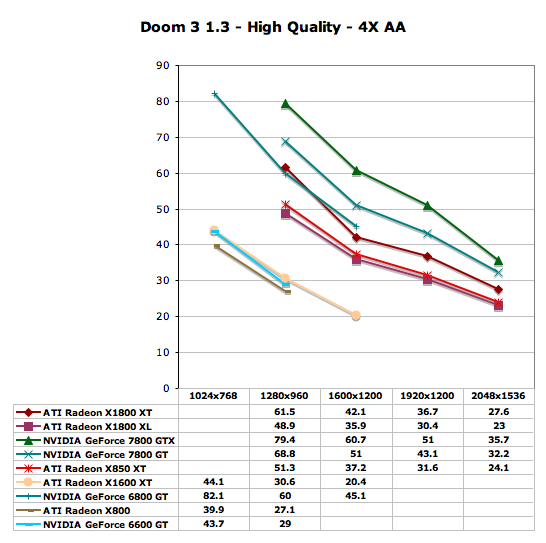
Enabling AA drops performance by a similar proportion on the X1800 and 7800 series parts at high resolutions, with low resolutions favoring NVIDIA hardware. In another twist that spits in the face of the trends that we have seen, the X1600 XT handles AA much better than the 6600 GT and shows a lower percent impact than most of the other cards in the test.
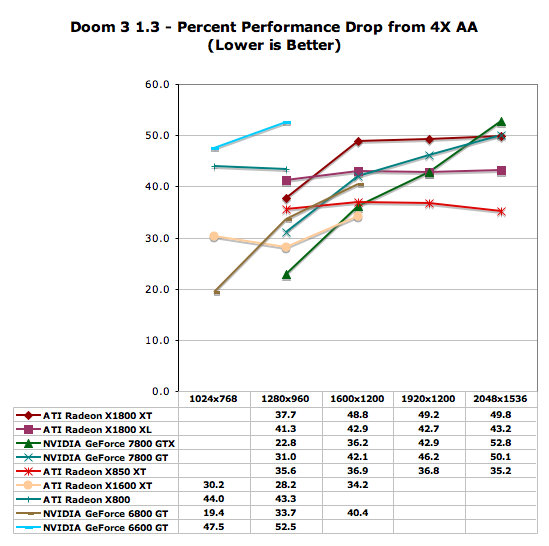
Everquest II Performance
If we had to choose a game that has the potential to stress the GPU more than anything else, it would be Everquest 2. The Extreme Quality mode is currently not worth testing as no one has a system capable of running the game at that mode smoothly enough. Very High Quality mode (which we run in our tests) is demanding enough as it is. The cut-off in playability with this game is also much lower than an FPS style game; it isn't until dropping below 20 frames per second that playability starts to degrade. We were unable to enable AA here, so we will have to settle for just looking at performance with everything else cranked up.
At the high end, it looks like we are limited to near 50 frames per second. Our high end cards are all crowded together at 1280x960, but increasing resolution serves to separate them pretty well. The 7800 series parts maintain a lead over the X1800 cards with which they compete. The 6800 GT and X850 XT do a good job of keeping up with the X1800 XL for the tests we ran.
While the X1600 XT does a good job of performing at X800 levels and staying playable up to 1600x1200, it does not come close to performing near the 6800 GT. X1300 Pro users will have to stick with 1024x768 for playability, but those with 1280x1024 flat panels will probably just want to sacrifice some visual effects.
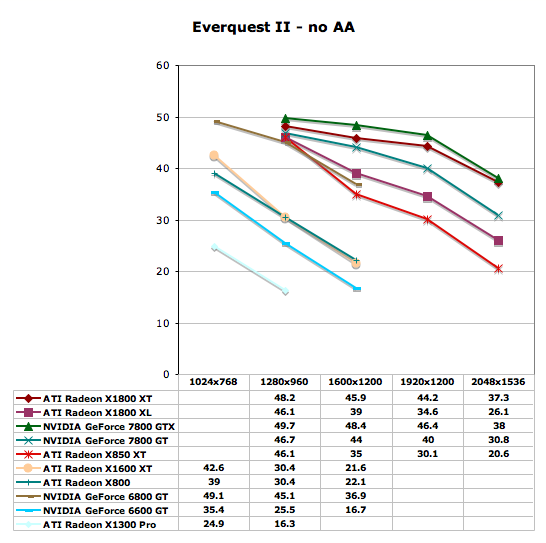
Far Cry Performance
Crytek has done an excellent job keeping up with the times. As new technologies come out, it seems like they do their research into how to use them on their production game. Incorporating SM3.0 code, geometry instancing, HDR, and the like into their last patch adds value to their game, gives us a platform with which to test the current incarnation of their engine, and gives potential game engine customers a look at what they could be getting in a shipping product. We are already hearing about another patch that will further extend the impact of HDR on the game, among other things. For these tests, we crank the graphics quality settings up to very high (ultra high for water) and let the chips fall where they may. The demo that we used for this test was the built-in regulator demo.
These tests show the top end ATI and NVIDIA cards running neck and neck. The 7800 GT leads the X1800 XL in performance (which is on par with the 6800 GT in the tests that overlap). The X1600 XT is able to perform better than the 6600 GT, but we should hope to see that from a card that costs over 50% more if MSRP is anywhere near street price. Again, the X1300 shouldn't be played at over 1024x768 unless the settings are dropped.
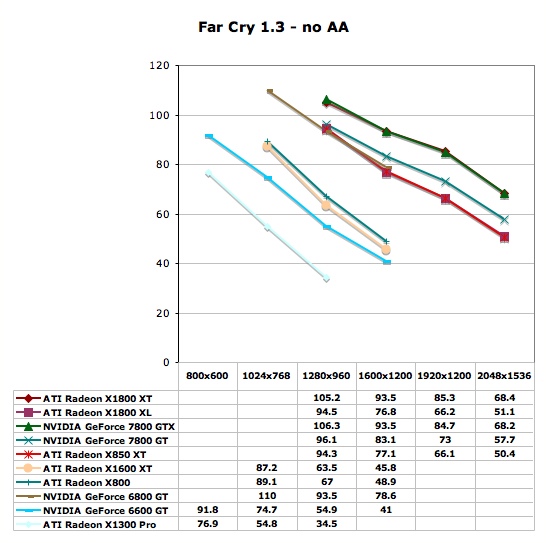
Enabling AA gives the advantage to the X1800 XT while the X1800 XL still lags behind the 7800 GT. The X1600 XT performs much better than the 6600 GT (which we wouldn't recommend running with AA).
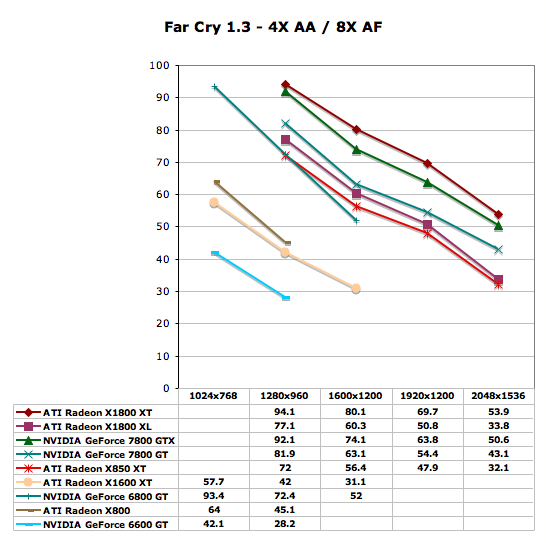
Once again, the X1800 XT handles the impact of AA better than any other card. The added memory bandwidth is likely the reason why we keep seeing such good handling of AA. The 7800 GT and 7800 GTX both handle AA almost as well as the X1800 XL (and finally over-take the new ATI part at 2048x1536).

The Chronicles of Riddick Performance
We don't have as much data as we would like for The Chronicles of Riddick as it looks like the game itself checks the capabilities of our monitor before allowing a setting to be run. While the monitor that we use to test games at high resolutions is capable of running at up to 2048x1536, the data it reports to graphics cards is unreliable. NVIDIA and ATI allow for the ability to specify manually the limits of one's monitor, but in this case, the game goes straight to the flawed source. In any case, all these tests were run with the shader level set to 2.0.
With the data that we have, the high end NVIDIA cards absolutely dominate this benchmark. The 6800 GT even performs as well as the X1800 XT. The X850 XT keeps up with the X1800 XL, and the only surprise is that the X1600 XT performs the same as the 6600 GT. Once again, the playability of the X1300 Pro is limited to 1024x768.
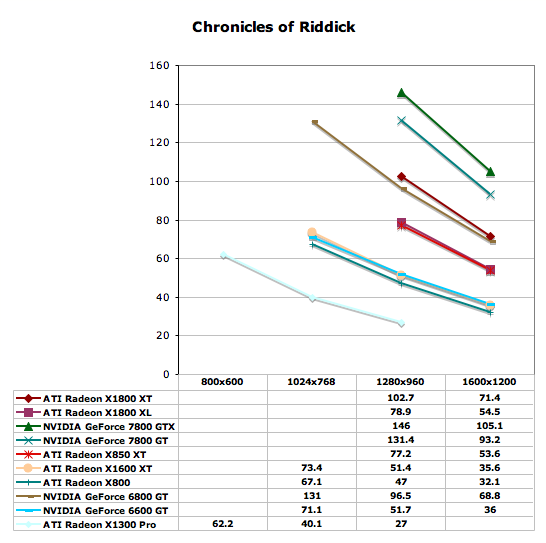
Splinter Cell: Chaos Theory Performance
Splinter Cell: Chaos Theory is a beautiful stealth action game that makes excellent use of light and shadow. Their extended SM3.0 features are beautiful, but we tested without SM3.0 enabled for consistency. These numbers are based on the lighthouse demo that comes with the games, and we used the benchmark scripts created by Reverend of Beyond3d.
This is one of the few games that shows the X1800 XT with a clear lead over the 7800 GTX with no AA enabled. The 7800 GT still bests the X1800 XL, and the X1600 again performs on par with a much cheaper part in the 6600 GT.

Turning on AA serves to increase the X1800 XT performance advantage considerably. The future high end part from ATI will allow Splinter Cell 3 to run at 2048x1536 with 4xAA and 8xAF at a playable frame rate. The X1800XL competes directly with the 7800 GTX in this benchmark with the 7800 GT lagging behind. In this way, Splinter Cell shows us something almost the reverse of Doom 3 and Chronicles of Riddick performance.
While the X1600 XT does post better numbers than the 6600 GT, we will be more interested in how the cheaper X1600 parts will hold up against the very popular NVIDIA mid-range part.
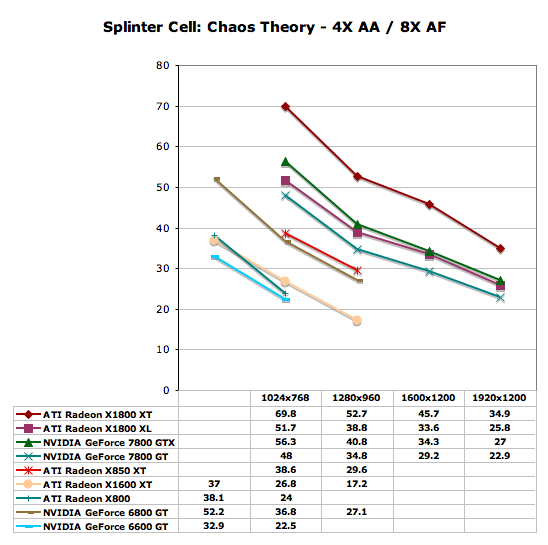
Once again, we see the X1800 XT handle the impact of antialiasing better than all the other parts. The X1800 XL also adapts better than the NVIDIA cards. While the 6800 GT keeps up with the X1600 XT in terms of AA impact, the 6600 GT doesn't do quite as well.
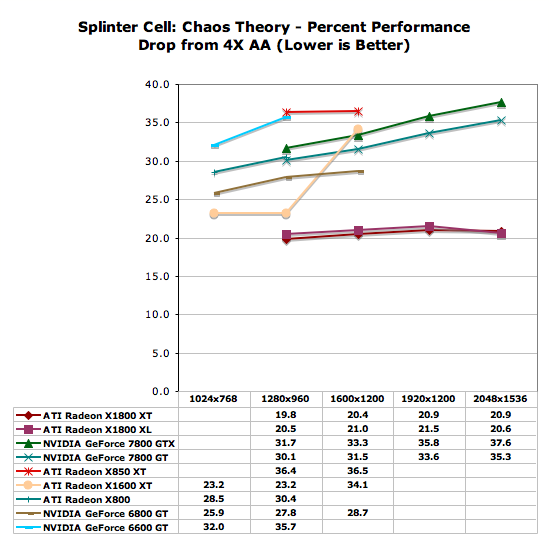
Final Words
The additional tests that we've run help to solidify our assessment of ATI's situation with the X1000 line. Our tests show that the high end ATI cards handle enabling antialiasing better than NVIDIA cards overall. The X1600 XT fairly consistently performs much worse than the 6800 GT and a little better than the 6600 GT. The X1300 Pro doesn't perform nearly as well as the 6600 GT in our tests (though it costs nearly the same), doesn't perform at playable framerates over 1024x768 in high quality modes, and enabling antialiasing is simply not an option.
The X1800 XT will be good competition for the 7800 GTX, besting it in many cases when antialiasing is enabled at higher resolutions. The X1800 XL competes fairly well with the 7800 GT, but the NVIDIA card generally comes out on top in the tests that we ran. OpenGL games are still a hurdle for all the ATI cards to overcome, but it seems as if the X1600 XT is more highly capable of mitigating the impact of a non-Microsoft API on performance.
The true bottom line of the goodness of these cards with respect to their NVIDIA counterparts is price. The MSRP data that we have (which is all we have to go on so far) is absolutely a deal breaker. At every step along the way, the NVIDIA parts that perform at or near the level of the ATI X1000 series cards look like they will have a $50 to $100 price advantage. As the NVIDIA parts have had the market to themselves for a while, their prices have managed to settle. ATI won't be able to benefit from the high prices that we usually see at a product launch because their parts just aren't worth the price premium.
But that's not all the coverage that we have planned for the new ATI parts. Stay tuned for some more in-depth Shader Model 3.0, image quality, and market analysis soon.







